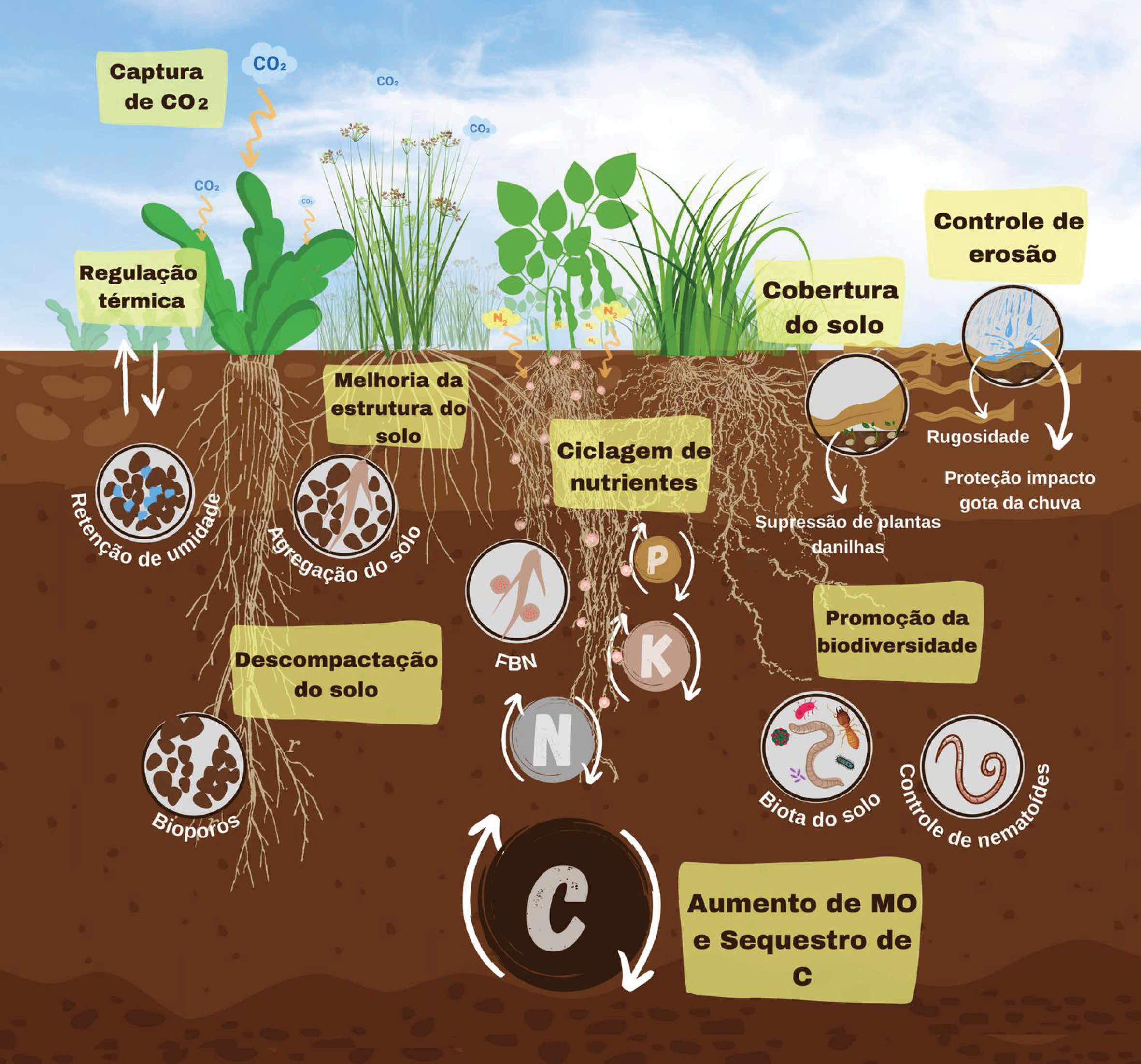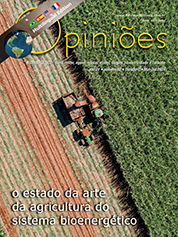Thiago Aristides Quintino
Gerente de Desenvolvimento Agronômico da Raízen
OpAA80
A importância da rotação de culturas
A agricultura regenerativa, conceitualmente, busca reunir valores que tornem a agricultura mais sustentável na ótica ambiental e, consequentemente, econômica numa abordagem que visa criar sistemas agrícolas mais produtivos e resilientes, buscando a conservação dos recursos naturais para gerações futuras como premissa básica.
Um dos principais pilares para este modelo é a conservação de solo, partindo de menor revolvimento, passando por manutenção de cobertura e chegando ao aumento da biodiversidade nele presente. A rotação de culturas tem seus benefícios amplificados como melhoria de componentes físicos, químicos e biológicos do solo com as plantas de cobertura que, também, promovem o controle da erosão através da redução do impacto da chuva, redução da enxurrada e erosões laminares e aumento da resistência do solo à desagregação.
Como método conservacionista de trabalho, o SPD (Sistema de Plantio Direto) ou PM (Preparo Mínimo) busca a redução do revolvimento de solo visando a manutenção das características químicas, físicas e biológicas do solo e, consequentemente, menor taxa de oxidação e mineralização da matéria orgânica, contribuindo para manutenção da fertilidade e consequente rentabilidade do sistema agrícola, proporcionando a possibilidade de ativação da máxima expressão do potencial genético sobre o pilar da conservação ambiental.
Considerada um dos princípios básicos da agricultura, essa prática garante que os microrganismos presentes no solo desempenhem um papel vital na fertilidade e na qualidade, pois afeta diretamente o crescimento das plantas e a produção agrícola por meio de práticas que visam a identificar intensidades de manejo que sustentam ou melhoram o solo de forma sustentável.
A ativação do microbioma do solo por meio da rotação de culturas nos apresenta algumas constatações que devem ser consideradas:
1. Solos quimicamente semelhantes não, obrigatoriamente, são idênticos biologicamente. A aplicação de técnicas como a rotação pode torná-los distintos nessa característica.
2. Todo solo saudável é produtivo, mas nem todo solo produtivo é saudável.
2. Todo solo saudável é produtivo, mas nem todo solo produtivo é saudável.
3. Solo saudável armazena mais água, e o microbioma é o que garante a estabilização dos agregados.
Aliado ao contínuo aporte de biomassa oriundo das plantas de cobertura, a rotação permite a diversidade da macrofauna bem como
o aumento dessa biomassa microbiana.
Esse ambiente é também cenário de muitas reações bioquímicas através da liberação de enzimas por bactérias e fungos micorrízicos arbusculares, além de seus metabólitos que são benéficos ao solo, pois favorecem a decomposição de resíduos vegetais, fixação biológica e ciclagem de nutrientes com posterior disponibilização, na forma inorgânica, para o crescimento das plantas, além da supressão de pragas, como, por exemplo, fitonematóides patogênicos.
Especificamente na cultura da cana-de-açúcar, os benefícios são ampliados com a melhoria da qualidade do vegetal, que é um primordial aliado do setor de bioenergia e, portanto, essencial para a redução da dependência de fontes não renováveis. A prática de plantar outra cultura na reforma dos canaviais já se mostrou muito importante, tanto no quesito de conservação do solo, quanto com a possiblidade de um retorno financeiro através do cultivo de culturas com produção de grãos ou popularmente conhecido Sistema GRANA – Grãos em Rotação com Cana. Dentre todas as vantagens, podemos citar:
• cobertura do solo, reduzindo perdas por erosão;
• aproveitamento da capacidade de produção dos solos;
• melhoria das capacidades física, químicas e biológicas;
• diminuição incidência de pragas, doenças e ervas daninhas;
• diversificação receitas;
• fixação e ciclagem de nutrientes;
• melhoria do aproveitamento e eficiência dos fertilizantes e corretivos;
• intensificação da atividade biológica do solo.
No entanto, alguns cuidados também são necessários: planejamento estruturado e disciplina operacional (“timing” entre operações).
Outro forte aliado à conservação ambiental do solo é o uso do controle de nematóides que se alojam nas raízes e dificultam a absorção de água e nutrientes. A mudança ambiental da combinação entre plantas de cobertura e rotação permite uma forma eficaz e sustentável de manter afastados esses nocivos parasitas.
Como afirmado anteriormente, a rotação de culturas no setor agrícola é primordial quando se trata de garantir a conservação e a diminuição da exaustão do solo, pois a técnica existe com o objetivo de alternar diferentes culturas em uma mesma área que é utilizada ao longo dos anos.
Dessa forma, tem-se a melhoria qualitativa do solo e do ecossistema em geral, uma vez que a matéria orgânica presente no local auxilia na melhoria da saúde do solo e promove a biodiversidade e o controle de pragas provenientes da cultura ali desenvolvida.
Além disso, o aumento na entrada de biomassa vegetal por meio de plantas de cobertura no sistema de produção incrementa os teores de matéria orgânica no solo e, consequentemente, o estoque de carbono, que, além do efeito na ciclagem de nutrientes, também contribui para a adaptação e mitigação de mudanças climáticas causadas pelo aumento da emissão de gases de efeito estufa.
A atividade microbiológica também tem sido usada como indicador da qualidade do solo, pois, geralmente, mais de 90% do fluxo de energia do solo passa por decompositores microbianos. Atualmente, com avanço tecnológico, temos as análises metagenômicas, em que é possível acessar o DNA de comunidades microbianas e inferir informações identificando quais espécies de microrganismos estão presentes no solo, suas funções e nível populacional.
Além dos benefícios diretos para a saúde do solo e a produtividade agrícola, a agricultura regenerativa é um essencial parceiro da mitigação de C02 e, portanto, na diminuição das mudanças climáticas, pois, ao promover uma atividade de enriquecimento do solo utilizado, garante também que haja o sequestro de carbono.
A agricultura regenerativa tem sido proposta como um meio alternativo de produção de alimentos com menores impactos ambientais e/ou sociais, ou mesmo positivos, já que a prática tende a aumentar a sustentabilidade na produção de alimentos, inclusive, fazendo parte de estratégias para mitigar as mudanças climáticas.
Pode-se dizer que o objetivo da agricultura regenerativa não é restaurar a ecologia e a função biológica pré-agrícola nativa, mas sim alavancar os processos ecológicos na natureza dentro de um sistema agrícola para melhorar a saúde desse mesmo sistema.
Nesse contexto, a rotação de culturas com a alternância de espécies de vegetais em áreas agrícolas destaca-se como ferramenta de melhoria da saúde do solo e constitui-se na melhor alternativa para uma agricultura sustentável e regenerativa.






